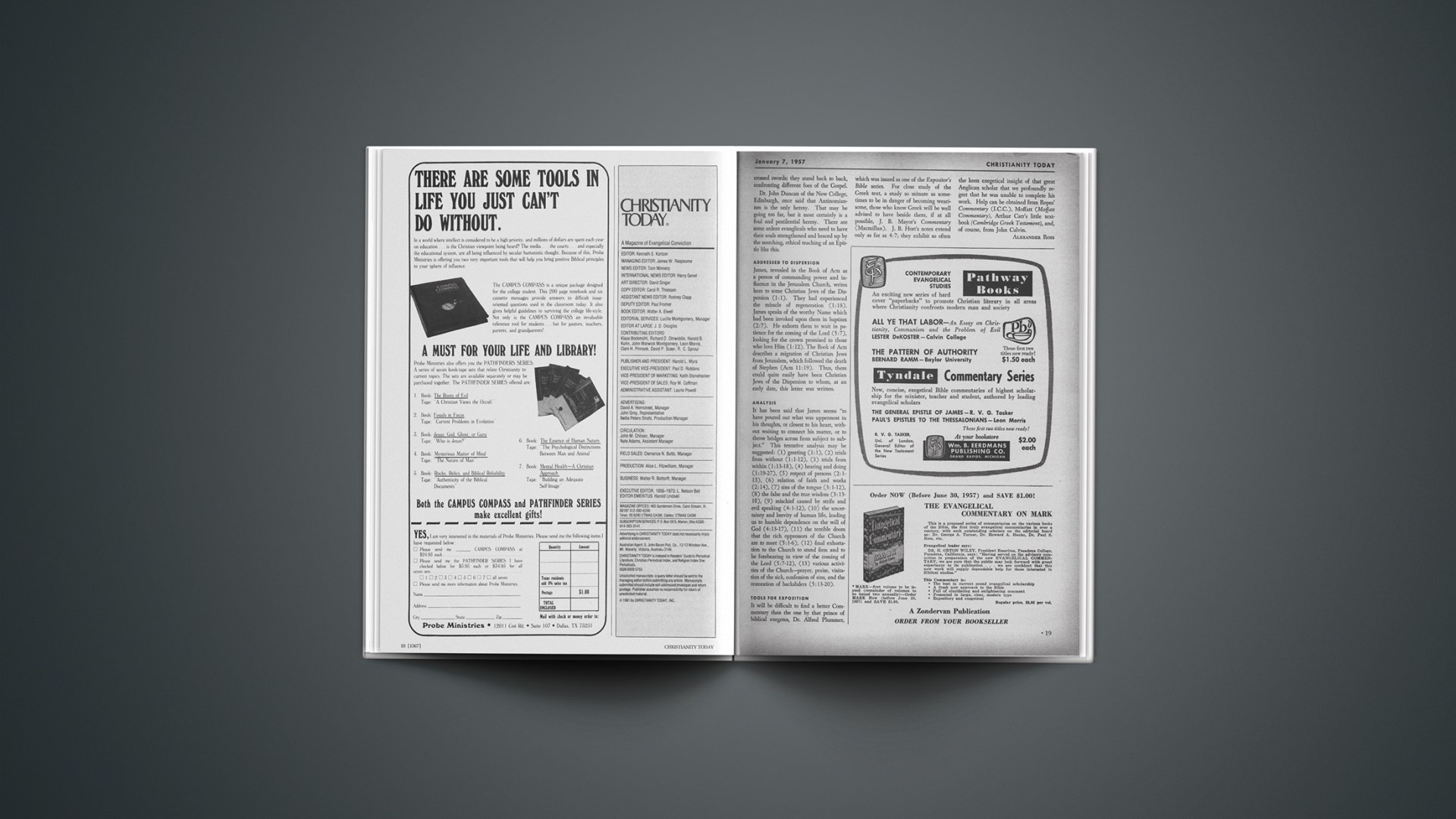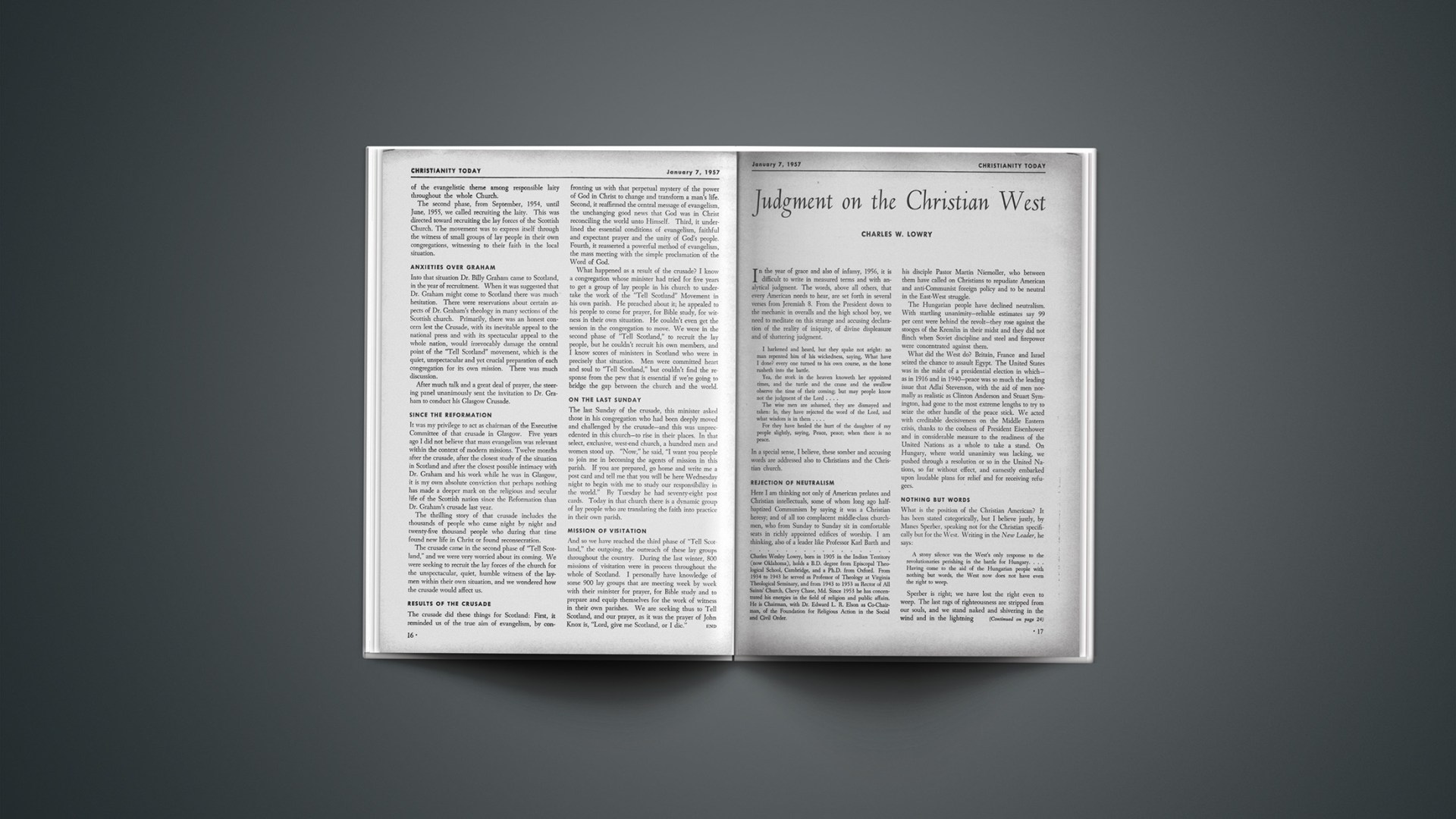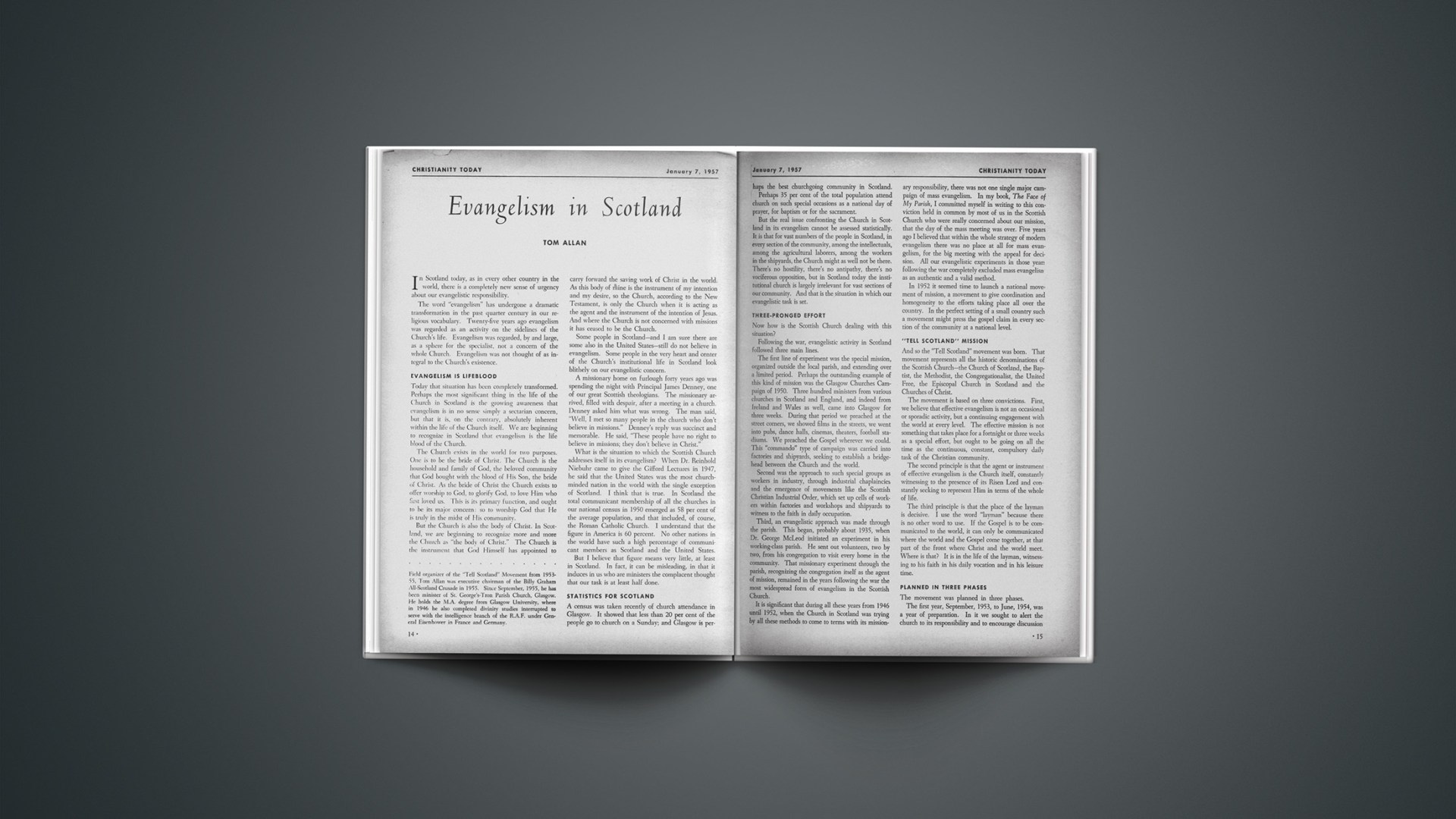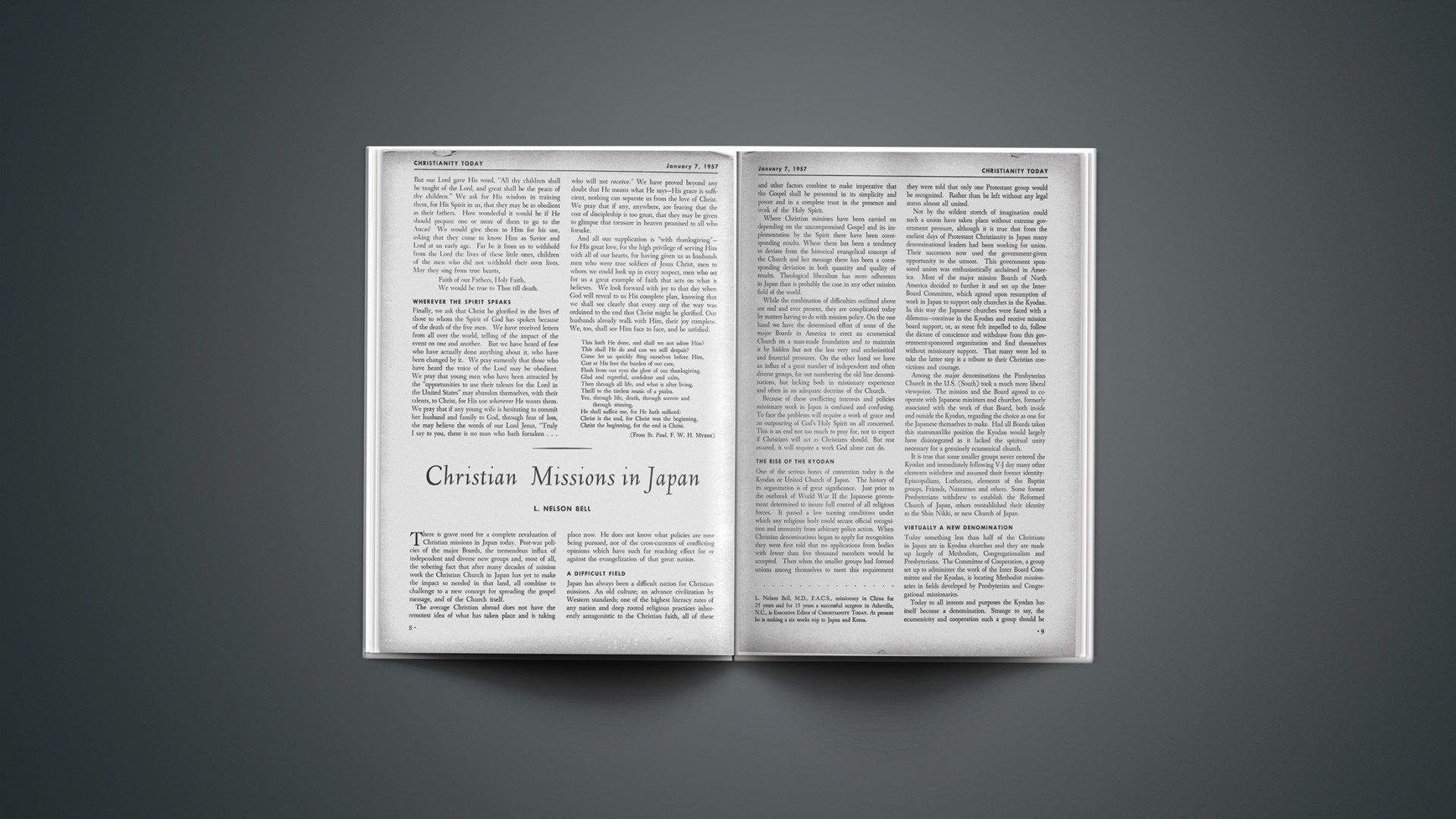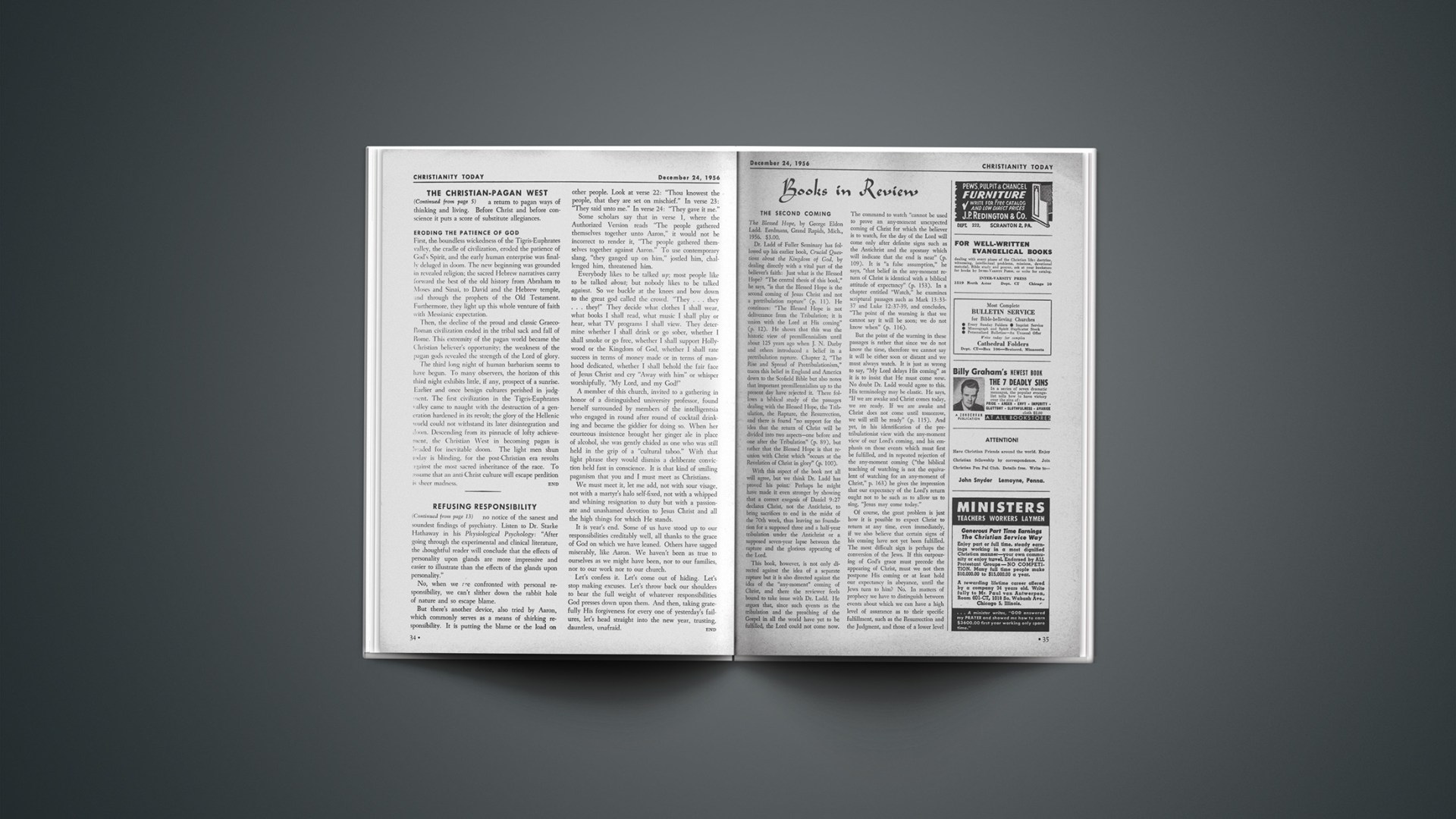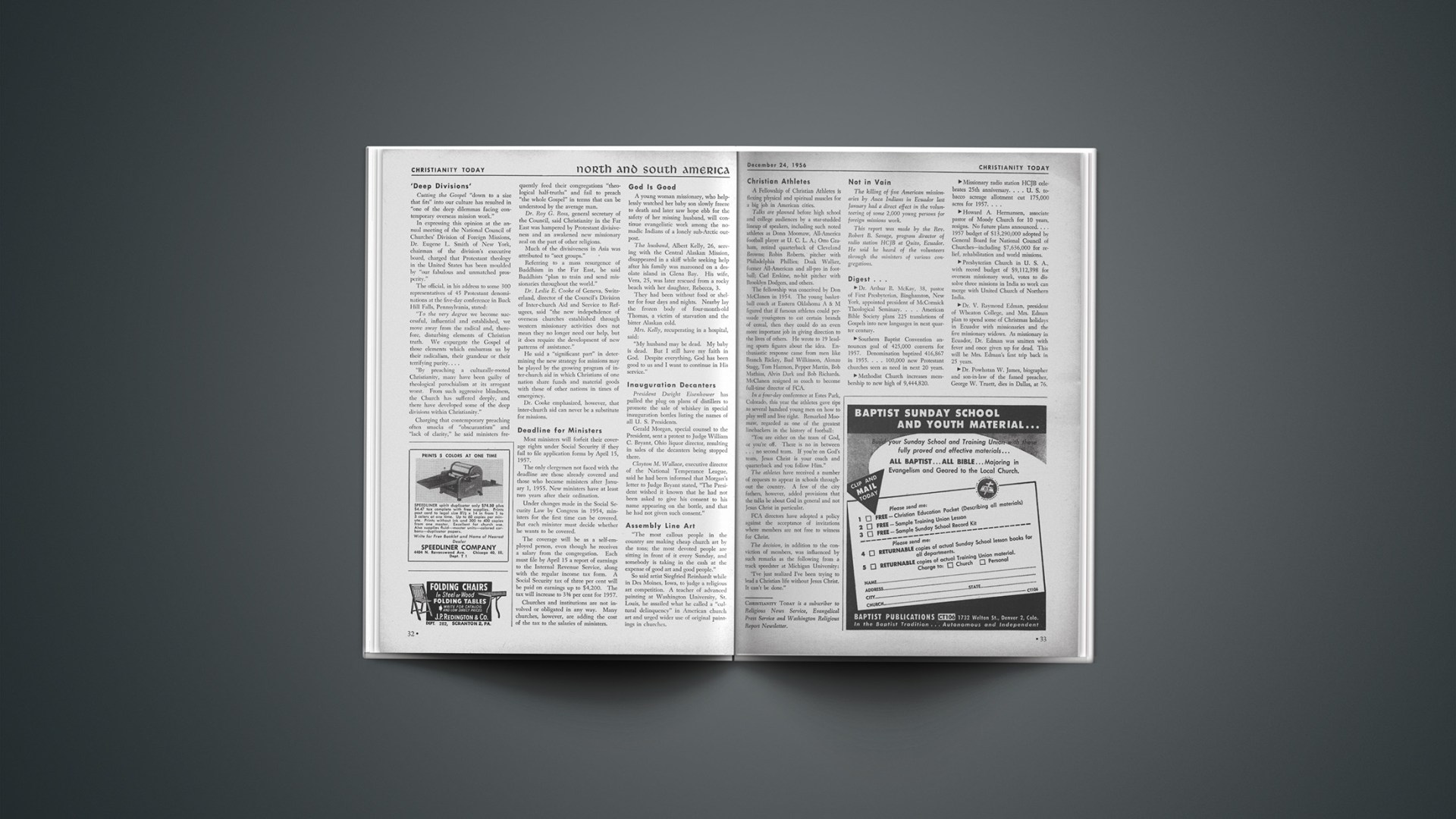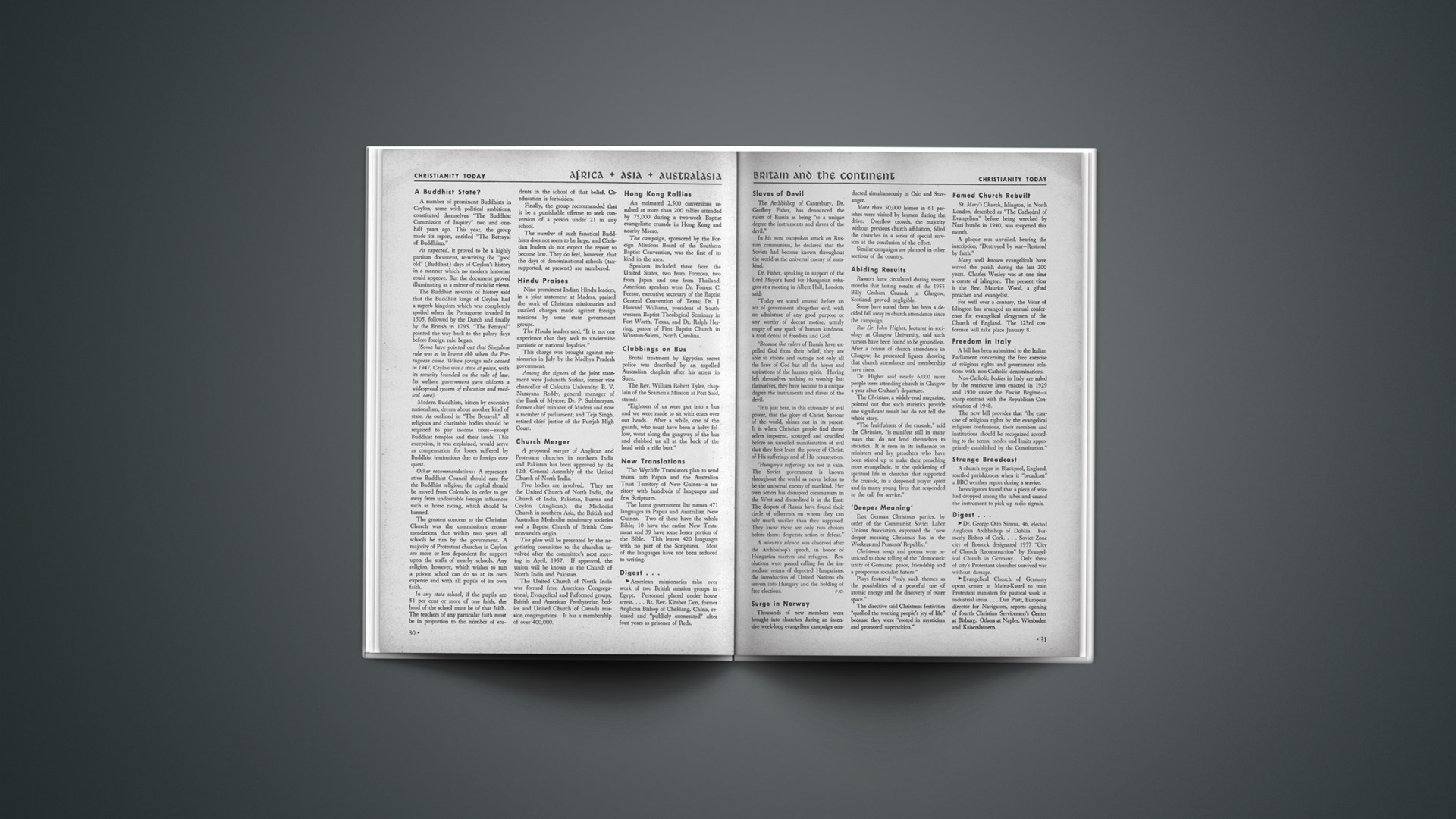The range of thought in this epistle of James, some have said, is so limited that we are kept on rather a pedestrian level. Even if that were a strictly accurate estimate of the Epistle, let us remember that our flight to the heights from which far-reaching vistas of truth open out before us is a preparation for returning to the ordinary walk of life on its more prosaic levels. The supreme test of the quality of our religion is how we react to the long monotonous trudge on hard and stony roads, and not in the moments of ecstatic communion or in moments of specially strenuous activity (Isa. 40:31). We ought to be grateful to find in the Canon of Holy Scripture a book as severely practical as this Epistle, a book that contains words as sharp and uncompromising as these: “Be ye doers of the Word, and not hearers only, deluding your own selves” (1:22); “you believe that God is one, and you are quite right; evil spirits also believe, and shudder” (2:19, Weymouth).
The great Christian scholar, Origen of Alexandria (circa ca. A.D. 230), is the first Church writer who explicitly quotes this Epistle as Scripture, ascribing it to James, the Lord’s brother. In the Shepherd of Hermas, written about the middle of the second century, we hear fairly clear echoes of the teaching of the Epistle. In an earlier writing, the Epistle of Clement of Rome, written about the year 96, the echoes are much fainter; indeed, the evidence supplied by this writing is of doubtful validity. But, if the external evidence for the Epistle should appear to be rather vague and inconclusive, there seems to be no doubt about the evidence supplied by the Epistle itself. It enables us to reach some conclusions with regard to the authorship that seem to be irrefutable.
Authorship Of James
The writer was a Jew. He speaks of Abraham as “our father” (2:21), he applies to a Christian place of worship the word “synagogue” (2:2), he uses the Jewish word “Gehenna” in 3:6 and a specifically Jewish name for God in 5:4. He was a Jew of Palestine, knowing well its early and latter rains (5:7; cf. Deut. 11:14) and its hot burning wind that withers he grass (1:11). The name of this Jew was James, and the only one of that name mentioned in the New Testament whose claims call for any scrutiny here is James, the Lord’s brother. The disciple of Jesus, James the son of Alphaeus, seems to have been an obscure and undistinguished person; and James, the son of Zebedee, died early as a martyr, in the year 44 (Acts 12).
There are three interesting lines of argument in connection with the internal evidence that students might profitably explore. In my commentary on James in the New International Commentary (published in 1954) I have explored them with a fair degree of fullness. Here I simply mention them.
1. In the vocabulary of the Epistle there are some coincidences of language with the vocabulary of the speech of James at the Jerusalem Council of the year 50 and the letter issued by that Council (Acts 15). There are also two coincidences of language between the vocabulary of the Epistle and some of the words of James recorded in Acts 21:24 and 26. 2. The Epistle is the work of just that type of mind which is typical of James in the New Testament and in Church tradition. 3. The Epistle contains more reminiscences of the teaching of Jesus, and especially of the Sermon on the Mount, than all the other apostolic writings put together. The writer is not quoting from our Gospels; he must have stood very close to Jesus, to be able to reproduce so much of His teaching in a way that is strikingly independent.
If these three features of the Epistle are studied carefully and judicially, they will be seen to provide strong evidence that points in the direction of James, the Lord’s brother, as the author. The evidence is cumulative in both force and volume. This James is the only James in the early Church who was so well known that the simple designation, “James, a servant of God and the Lord Jesus Christ” was sufficient to identify him at once to his readers. The Epistle has nothing whatever to say about the controversy that led to the holding of the Jerusalem Council of the year 50, the controversy about the place of Gentiles in the Church. Some have argued that this shows that it was written long after that Council, when that controversy had fallen into the category of “old unhappy, far-off things, and battles long ago.” A far more reasonable theory, and one to which the majority of scholars adhere, is that it was written before the Council. Various hints here and there in the Epistle also point to an early date. Even so radical a scholar as Dr. A. T. Cadoux, in his little book on The Thought of St. James (published in 1944) advocates the early date, mentioning such arguments in support of it as the simplicity of the greeting, the use of “synagogue” for a Christian place of worship and the reference to “elders” only as officials of the Church (5:14).
Alleged Weaknesses
Some have looked with suspicion on the Epistle because of what they have described as its lack of theological teaching. We can, however, find a good deal of what has been called “compressed theology,” in such phrases as “Of His own will He brought us forth” (1:18), “the implanted Word” (1:21), “heirs of the Kingdom” (2:5) and the like. A remarkable feature of the Epistle that deserves careful study is the witness that it bears unobtrusively, at more than one point, to the Deity of Christ. In its very first words James stands as a servant of the Lord Jesus Christ, who is one with God. Jesus is the Judge who stands before the door (5:9), and His Name is the resource of the Christian in sickness and sin (5:13–15). As Bengel, Warfield, J. B. Mayor and even so advanced a scholar as James Moffatt have held, in the first verse of the second chapter Jesus is referred to as “our Lord Jesus Christ, the Glory.” As Moffatt says, the Christian religion is there described as belief in the Lord Jesus Christ, Who is the divine Glory, which is a striking term for Christ as the full manifestation of the divine presence and majesty. Severely practical the Epistle may be, but, as I have said in my commentary, the practical exhortations “have their roots in deeper things, in the vital truths of Christian theology, though these roots, as is natural, are, to a large extent, hidden from the eye.”
Others have criticized this Epistle because of what they regard as its lack of evangelical fervor. Luther had doubts about it because he thought that it contradicted the Pauline doctrine of justification by faith. This is a very serious misunderstanding. The plain truth is that Paul and James deal with entirely different subjects. Paul in his teaching on justification is combating Jewish legalism; James is making his protest in the interests of morality, against Antinomianism. We may put it like this: they are not antagonists facing each other with crossed swords; they stand back to back, confronting different foes of the Gospel.
Dr. John Duncan of the New College, Edinburgh, once said that Antinomianism is the only heresy. That may be going too far, but it most certainly is a foul and pestilential heresy. There are some ardent evanglicals who need to have their souls strengthened and braced up by the searching, ethical teaching of an Epistle like this.
Addressed To Dispersion
James, revealed in the Book of Acts as a person of commanding power and influence in the Jerusalem Church, writes here to some Christian Jews of the Dispersion (1:1). They had experienced the miracle of regeneration (1:18). James speaks of the worthy Name which had been invoked upon them in baptism (2:7). He exhorts them to wait in patience for the coming of the Lord (5:7), looking for the crown promised to those who love Him (1:12). The Book of Acts describes a migration of Christian Jews from Jerusalem, which followed the death of Stephen (Acts 11:19). Thus, there could quite easily have been Christian Jews of the Dispersion to whom, at an early date, this letter was written.
Analysis
It has been said that James seems “to have poured out what was uppermost in his thoughts, or closest to his heart, without waiting to connect his matter, or to throw bridges across from subject to subject.” This tentative analysis may be suggested: (1) greeting (1:1), (2) trials from without (1:1–12), (3) trials from within (1:13–18), (4) hearing and doing (1:19–27), (5) respect of persons (2:1–13), (6) relation of faith and works (2:14), (7) sins of the tongue (3:1–12), (8) the false and the true wisdom (3:13–18), (9) mischief caused by strife and evil speaking (4:1–12), (10) the uncertainty and brevity of human life, leading us to humble dependence on the will of God (4:13–17), (11) the terrible doom that the rich oppressors of the Church are to meet (5:1–6), (12) final exhortation to the Church to stand firm and to be forebearing in view of the coming of the Lord (5:7–12), (13) various activities of the Church—prayer, praise, visitation of the sick, confession of sins, and the restoration of backsliders (5:13–20).
Tools For Exposition
It will be difficult to find a better Commentary than the one by that prince of biblical exegetes, Dr. Alfred Plummer, which was issued as one of the Expositor’s Bible series. For close study of the Greek text, a study so minute as sometimes to be in danger of becoming wearisome, those who know Greek will be well advised to have beside them, if at all possible, J. B. Mayor’s Commentary (Macmillan). J. B. Hort’s notes extend only as far as 4:7; they exhibit so often the keen exegetical insight of that great Anglican scholar that we profoundly regret that he was unable to complete his work. Help can be obtained from Ropes’ Commentary (I.C.C.), Moffatt (Moffatt Commentary), Arthur Carr’s little textbook (Cambridge Greek Testament), and, of course, from John Calvin.
Is Modernity Worth Sparing?
The question so little raised, but so pressingly urgent, is whether Western culture is any longer worth sparing? After all, if salvation (the term is theological) is ethical, by what right do men expect a halo permanently to hallow their pagan ways? Today not sin, but rather Christianity is subterranean. The basic Christian dogmas are marginal to the prevailing outlook on life. The ideas by which men shape their social life have become warped and individualized. Art and literature are no longer simply Christian-pagan, but pagan-Christian; the humanistic motif has triumphed and reaches even into the churches. When has paganism dared, as in our decade, to incorporate even Jesus as one of its fleshly themes? When has the music and song of the churches, historically centered in the Psalms, erected so wide a bridge to the world, so that the world itself replies in kind, although carnally, blending the spiritual motif and rock-and-roll with scant sense of incongruity and attracting to religion many who do not take it seriously? Our streets are crammed with pagans, and not even the revival of religion—and an indubitable awakening there is among many sincere Christians—can hide from view this conformity of religion to paganism. Indeed, more worldly-wise adults in the Americas are said to consult newspaper horoscopes than consult the Bible for light on the day’s decision.
Each passing decade now finds the inhabited world in a state of instability and shock worse than the preceding period. Every sweep of the horizon discloses widening crevices. The soulless nations remain as bleak signposts after the landslide of Western civilization into abysmal pagan depths. In civilized Europe in 1945 and 1946, in the aftermath of World War II, more people succumbed to cold and starvation than for many preceding generations or centuries; millions of refugees from bombed cities or hostile governments begged for asylum; fully a third of the people in France and Italy voted for Communist party candidates; the homeless survivors of oppressed continental Jewry fled to Palestine for refuge, while a million Arabs were dispossessed in that dissension-wracked land. The ascendancy of the white race seems nearer its eclipse.
Indeed, the future of human history itself lies in doubt. Henry Steele Commager, in The American Mind (1950), points to the unparalleled “breakdown of personal integrity … looting and destructiveness, … sexual promiscuity” discovered in the second American war, and remarks that the two world wars failed to induce in the American “either a sense of sin or that awareness of evil almost instinctive with most old world peoples … but accentuated his own assurance of power and success. His culture was still predominantly material, his thinking quantitative …” (pp. 432, 410). The old landmarks of Christian culture are vanishing, and some “prophets” are left with no more basis for optimism about the future than a confidence that man is a “tough animal.” National fatigue is spreading, and despair increasingly clouds the face of the man in the street.
The world is less one world than ever, except in its sins. It has less homogeneity; beyond a common veneration of science, a common dread of the atomic bomb, the great unanimities slip away. The Kremlin, depending on the Marx-Lenin philosophy, regards a clash with the Western powers as inevitable. Europe, the home of modern Western civilization, is caught in the tug of war between the U.S.A. and the U.S.S.R. The United Nations itself is frustrated by a lack of unity; any great power bent on war can exercise its veto power, and even small powers have already spurned U.N. verdicts.
The real question before us is not whether Europe and America will be cut to the Soviet pattern, or Russia to the Anglo-Saxon; rather, it is whether the whole world in our day will go down in nihilism. We are face to face not merely with one of the great divides of history, but with the divide of divides in the sphere of human decision.
When C. Virgil Gheorghiu penned The Twenty-fifth Hour, a best-selling French novel, he applied that title deliberately to “The hour when mankind is beyond salvation—when it is too late even for the coming of the Messiah. It is not the last hour, it is one hour past the last hour. It is Western Civilization at this very moment. It is NOW.” Although Arnold Toynbee might write (A Study of History, p. 554), “We may and must pray that a reprieve which God has granted to our society once will not be refused if we ask for it again in a humble spirit and in a contrite heart” (a stupendous if, indeed). Gheorghiu speaks of Western civilization as already being superseded. Only while we can be sure that a man and a culture have not drifted past redemption’s point does any semblance of hope remain. In any event, we are far down the road to final destruction and doom. Our culture is afflicted with moral paralysis, and may never learn to walk again. At least, hope is fast running out that it can recover from its crippling deformities.
Only skilled pilots can maneuver the ship of Western culture any longer through the twilight of midcentury chaos toward even the hope of a sunny dawn. No other post-Christian generation has stood as desperately as ours in need of expert navigational advice. Sprawling mudflats and sloughs extend treacherously on every side, and the sea of life is encumbered with obstacles that faith alone can move.
Indeed, a deeper problem vexes us today: how long before a people set adrift lose their capacity for taking compass bearings? What are the limits of heaven’s tolerance? When does collective shame reach a depth from which there is no route back? When is the cup of iniquity in a given culture full to overflowing? When is “civilization” divinely outlawed, and faced with a death penalty? Dare we any longer look for the spiritual reconstruction of a culture that stinks already? Has it, like Lazarus, perchance already been dead four days, and the Lord refuses now to come near its grave?
The Christian concern to “rescue” the Christian-pagan culture of the West is remarkably strange. Whatever bears the impress “pagan” is marked for judgment, as the early Christians well knew. The apostolic community was aware that “this present evil world” is near death, that the forces of Satan almost everywhere intrude into its life, that in this world of wars and rumors of wars there is no unending peace. They made no goal of rescuing a pagan culture; nor would they have ventured to perpetuate a pagan-Christian, or a Christian-pagan, culture. What God sends to its death in judgment neither prophet nor apostle can resurrect. And the pagan spirit is doomed, no less in A.D. 1956 than in A.D. 1. Indeed, only a Christian-pagan conception of the Church’s task can be committed absolutely to the goal of cultural rescue—for this implies a primarily social conception of the Gospel and a highly optimistic view of society and history as well.
To some, it may seem a needless concession to pessimism to speak of modern culture as headed for doom and as outside the pale of redemption. But to those familiar with the New Testament this perspective cannot but appear realistic. The lively sense of historical end-time produced in the early Christians a quite different expectation from that among most modern Christians, many theologians included, who think the possible extermination of a pagan-Christian civilization on this fair planet an intolerable and insufferable presumption. That is why, to this Christian-pagan way of thinking, committed at all odds to the survival of a Christian-pagan culture, the blessing of the Church is conferred upon Christian-pagan strategy: the United Nations becomes the only real hope for peace, the integration of the races takes priority over the regeneration of the race, and so forth. The church of the hyphen, of the Christian-pagan disposition, made room even in its divinity schools for professors hostile to all supernaturalism, who promoted the organization of the Church while yet they were enemies of the evangel, propagating instead (as the essence of Christianity) the mirage of the social gospel. The twentieth-century church yielded to Communism, with its radical atheism, a role of challenge against the Christian-pagan patterns of our day more dynamic than the Christian-pagan forces themselves retained. Communism ranged against a pagan-Christian culture, in the interest of paganism, displays more zeal than those segments of the Christian camp whose main interest is the perpetuation of a Christian-pagan order. Both have lost the vision of Augustine’s The City of God; one is still enamored of Plato’s Republic, while the other is committed to the Manifesto of Marx and Engels.
For the early Christians, the only hope for the whole world lay in the appearance within it of what Professor F. Van Der Meer refers to as “a new category of men … ‘christanoi’ or ‘christians’ ” (in Atlas of Western Civilization, p. 36). The advancing Christian witness added a new dimension to human personality, one that the Bible depicts in the idiom of regeneration, justification and sanctification. Redemption through Christ altered man’s sensibilities in every sphere of life. The early Christians were not committed, therefore, to the perpetuation of Graeco-Roman culture. They preserved what was compatible with their faith, but they were not primarily concerned with the fate of a civilization which, however religious, was not built on foundations of genuine spirituality. They knew that only supernatural regeneration produces men and women of indomitable faith, unshakable peace, superb morals and neighbor-love. They knew because they had participated in the life of the old culture before their walk with Christ. They did not regard it as a Christian responsibility to aid a dying culture in exploring non-Christian or pagan-Christian avenues of survival. They had a Gospel to preach, and they preached it as to dying men and doomed nations.
The great frontiers before us all now are either nihilism or repentance and faith, for the present soul fatigue must lead, if not to spiritual renewal, then to disillusion and destruction. Once a world was dying in its sins, and Christianity seized the initiative. The safe era of the pax romana served as a framework for the propagation of the Gospel within the empire, and later the Christian witness systematically moved beyond the frontiers of the empire into barbarian lands. When the old culture succumbed, Christianity survived. The fate of the culture was not the fate of Christianity.
Only evangelical Christianity voices the biblical verdict: the modern mind is unsound, and requires renewal; the modern man stands in need of supernatural rebirth. Speculative philosophers still prattle about “maturing” the modern mind, or “shaping” the modern mind, but evangelical theology alone uses the relevant vocabulary: the utter necessity of regenerating the whole man.
The continuation of our very existence depends on the solution to basic problems, which Christianity alone has power to solve. The peoples of the world stand in desperate need of moral and spiritual enlistment, charging daily life with a sense of ultimate responsibility. We need to overcome the feelings of a generation which is not only incredibly ignorant of Christ, but which lives as if the Gospel were untrue. Many hear the Gospel today as something unbelievably novel, much like the throng in the Athenian market place.
The Christian needs to tell forth the fundamental facts of incarnational religion with a vividness to match the hour. He must enter, unintimidated by their modern eclipse, into a mood which grasps the elements of biblical revelation as new discoveries.
He need not fear because he speaks for a minority view. The power of Christianity has never depended on numerical superiority. The fisherman Peter by himself could resist the Hebrew religious leaders; the tent-maker Paul could carry the message of Christ through the far-flung Roman empire; the scholar Augustine in his day could convincingly interpret the debacle of history from the Christian standpoint; Luther could spark the Reformation and Calvin help sustain it; Wesley could turn the tide of secularism in England a century ago, and in our time Billy Graham can carry light to the Gentiles of three continents. So God through his anointed servants in succeeding generations becomes the light of a city, of a country, of a continent.
When the old Roman Empire crumbled, Christianity was scarcely known to the east of Jerusalem. In the Middle Ages, Europe alone (including Britain) was a virile center of Christian faith, transplanted later to America and other colonies. It is highly questionable whether there any longer exists a genuinely Christian nation on the face of the earth. But true followers of Christ are salted over the face of the globe. In Israel there are not many, fewer still in Egypt and Syria, but there are some; interdicted by totalitarian persecution in Red China, by autocratic religion in Colombia; eking out an apprehensive existence in Soviet Russia and satellite lands like Hungary; singing hymns in the jungles of the Cameroons and of the Congo—they remain the light of the world. In much of Southeast Asia the enterprise of “foreign missions,” as Western churches refer to it, seems to be drawing to an end. But the Church itself is in little peril of extinction even there. For dedicated nationals remain united with their living Lord. Indeed, recent events have quickened the cause of evangelism, for national workers now courageously proclaim the apostolic message in centers where the missionary movement itself has lost a biblical witness and vitality.
In his column “Spires of the Spirit” in the Washington Star, the chaplain of the United States Senate, Dr. Frederick Brown Harris, notes that even in the United States only a vigilant minority carries forward the fight for freedom. He recalls the sixteenth-century letter of Henry IV of France to his friend Crillon, who had failed to appear for a crucial battle. With biting scorn, the King wrote: “Go hang yourself, brave Crillon. We fought at Aques and you were not there.” Although applied to the tense modern battle for liberty, the anecdote can also be given a sharper turn. What more shameful verdict may history and eternity pronounce upon today’s Christian minister and the layman than this: “It was an end-time—for your generation and its culture—but you were not there”?
In 1956 no man, least of all a professing Christian, can afford to be neutral. These are days of unmasking, when neutrality discloses only those who desert the faith. Christian compassion leaves no man to his own destiny, for the lack of spiritual decision leads to hell, first on earth and then for eternity. It is not for us to answer the question “after 1956, what?” for God holds the future in His hands, but there is a question for whose answer we may be sure, “what must I do to be saved?” The Philippian jailor asked it centuries ago. The apostolic reply, “Believe on the Lord Jesus Christ, and you will be saved, and your household” (Acts 16:31), which wrought emancipation for one imprisoned soul, still has power to free all who are captive to the spirit of paganism. The Gospel in its very unveiling of the living God imparts at once a new hue to man and society, and to nature. It has power still to bind the awakening conscience to Christ and the inspired Scripture. If any word of Christ’s holds out hope to the West it must be found in His last instruction to the first century followers: “Go ye … and make disciples of all nations, baptizing them into the name of the Father and of the Son and of the Holy Spirit: teaching them to observe all things whatsoever I commanded you: and lo, I am with you always, even unto the end of the world” (Matt. 28:19 f).
A generation and a century, a civilization and a culture, which advance under alien commands are trooping always on the quagmire of doom. In passionate obedience to the Great Commission the Church fulfills her mission, while, by their response to the Christian confrontation, men and nations seal their destiny. In a time of peril the Church can do no better than to obey those majestic marching orders, rushing to the aid of dying men carrying their misplaced hopes with them.
Fear Of Man Ejected By Fear Of God
In his first inaugural address Franklin D. Roosevelt made the statement that has become a popular and common quotation. He said in part, “the only thing we have to fear is fear itself.” From pulpit and platform this quotation has been hurled to dispel the dark, overhanging clouds of fear—but without effect. Darkling clouds still lower over our civilization.
The fear of Roosevelt’s concern cannot be compared to the new dread that possesses the hearts of people. The fear of 1933 was defined by Roosevelt as “nameless, unreasoning, unjustified terror.” The present terror is not nameless, nor unreasoning nor unjustified.
Atomic and hydrogenic doom is the name of this fear. Scientists reason that the new destructive weapons are capable of destroying civilization, if not the earth itself. Dread of their use is indeed justified, for previous wars have revealed the demonic character of man.
Actually the new fear has displaced an older fear. Fear of man is superseding fear of God. Millions have shaken off the dread of God only to become enslaved by another anxiety—fear of the future, the fear of man for man. This modern apprehension terrifies as much as did concern of the hereafter implanted by the thought of fire and brimstone. Terror of unrighteous and of sinful man in possession of nuclear weapons has supplanted terror of the righteous and holy God.
In casting off the fear of God man has in reality repudiated that which alone will dispel the fear of man. Isaiah pointedly asked, “who art thou, that thou shouldest be afraid of a man that shall die, and of the son of man which shall be made as grass; and forget-test the Lord thy maker, that hath stretched forth the heavens, and laid the foundations of the earth?” (Isa. 51:12, 13). If man had not forgotten God, he would not now be living in fear of man.
Dread of man finds its source in distrust of divine power. The creature is thought to possess greater power than the Creator. Reflection on the infinite might of God evidenced in creation and providence generates confidence and peace. God has greater power to preserve than enemies have to destroy.
Only fear of God will cast out fear of man. This is not a terrifying or servile fear of God but a reverential fear. It finds its source in the realization of God’s power and righteousness. Wisdom and true religion are the fruits of reverential fear. It leads to Christ and commitment to His care and providence.
The present generation needs to learn that the only road to real security and confidence is found in the fear of God. Only Almighty God has the power and the love to protect man from man. Commitment to Him makes fear of man unreasonable, for God’s power is unbounded and man’s power limited. It makes terror unjustified, for the Psalmist has declared that those who abide under the wings of God’s protective care shall not be afraid for the terror by night. Only as a nation dwells under the fear of the living God does fear of man become “nameless, unreasoning, unjustified terror.”
Only to a God-fearing nation can it be declared in truth, “the only thing we have to fear is fear itself.”
A Preacher’s Great Temptation And The Spiritual Antidote
Every minister called upon to stand in the pulpit week after week should read 1 Corinthians 1:17 to 2:5 at frequent intervals.
Paul the great preacher, the divinely instructed theologian, places his finger squarely on the ever recurring temptation to proclaim God’s truth with “enticing words of man’s wisdom.”
To the unregenerate world the preacher is engaged in a foolish business and it cannot be otherwise. Man in his natural state wants a convincing sign or a well reasoned philosophy. To yield to such pressures is an insidious and deadly temptation.
It is not easy to preach a message which is a stumblingblock to some and meaningless jargon to others. Nevertheless that is the preacher’s mission.
But how can it be effective? Does not reason demand that we convince our hearers by the very force of logic and erudition? Take care! Paul found the preaching that has lasting effect is centered in Christ and Him crucified; foolishness to the world but the power of God to those who will believe.
An intellectual concept of the gospel message is vital, but there is also the absolute necessity of a personal relationship with the One Who made that Gospel possible. This experience of the burning heart enables one to rise above the ever-present temptation to please the “itching ears” in any given congregation. It is this recognition of the supernatural origin and effect of the Gospel which alone can compel the minister to preach the message on God’s terms and in God’s way.

